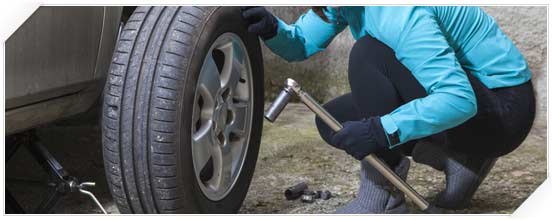It’s hard to understand how much maintenance and upkeep a vehicle takes until you own one. First-time car owners are not always prepared for the many routine problems that they may need to fix, or know what to look for when a problem arises. Want to be a car owner that knows how to keep their vehicles in good operating condition? You should be able to:
1. Check your Oil. Sure, you can always go to the shop – but knowing where the oil goes into the engine, how it drains, and how to check oil levels can help to prevent problems if you get sub-par oil service, or if the vehicle starts to burn or leak oil as it ages. Start by checking the owner’s manual to confirm the type and amount of oil that’s required, and how often the manufacturer recommends changing the oil for your model of car. Be sure to check your oil after the car is cooled down and use a rag to wipe the dipstick clean so that you will have a clear, accurate reading. The dipstick should have markings on it indicating a range for acceptable oil level.
2. Change a Flat Tire. The generic guide to changing tires involves simply taking off the lug nuts, jacking up the car and swapping out the hub – but what many owners find is that, for practical use, the standard jack and tools that came with the vehicle may not make this job easy. That’s why it’s a good idea to get actual, first-hand experience before having to fix a flat by the side of the road – familiarize yourself with the tools and process before you find yourself in the real situation.
3. Replace Windshield Wipers. Changing a wiper blade can be fairly simple, but drivers need to know which specific parts fit their model, and how to correctly attach the wiper blade to its housing. Different models of cars and blades require different types of mountings, so follow the instructions for your particular model, and once installed remember to clean them every so often to extend their life and effectiveness.
4. Add Wiper Fluid. This is a simple task that can be completed simply by knowing where the wiper fluid reservoir is located in your car. Keep tabs on fluid levels and fill up as needed, because running out of wiper fluid on the road, particularly in winter weather conditions, can cause dangerous windshield streaking, freezing, and loss of visibility.
5. Locate the battery. Another very good preparation for new car owners involves looking under the hood at where the vehicle battery is placed. Some batteries are easily accessible, while others are blocked by hoses or other interior parts. There may also be bolts holding a battery in place. Vehicle owners should also know the correct procedure for using jumper cables, if you don’t feel comfortable with the process; call a professional – as jump starting a car incorrectly can be dangerous for both you and your car. Each car is different, so check your owner’s manual for their recommendations and special instructions.
6. Check your Tire Pressure. Ensuring correct tire pressure can help to avoid serious accidents, while also saving fuel. That’s why newer models have tire pressure monitors on the dashboard. Look in the owners’ manual or on the inside of the driver’s side door for the standard tire inflation pressure recommended for your vehicle type. Using an air pressure gauge press the device evenly onto the valve stem for an accurate reading.
7. Locate and Assess Belts. Serpentine belts, AC belts and other drive belts are essential for 7. Keeping vehicle systems going, but they do wear out over time. Most drivers go to a shop to get belts replaced, but knowing what to look for in terms of looseness, dry rot and other wear can help turn a major roadside emergency into a simpler fix. Knowing where the belts are located and what they look like in good working condition can help you pinpoint problem areas.
8. Change a Car Light Bulb. Then there’s the array of little lights installed all over the vehicle – as the owner, you’ll probably have to start replacing these, one by one, at some point. Headlights, dome lights, brake lights and even license plate lights each have their own hidden bulbs, and finding all of the right crevices and connections can involve a little research, but are easy fixes that you can do yourself.
9. Check Coolant Levels. Along with wiper fluid, engine oil and other essential fluids, coolant is something your vehicle needs to run. Sometimes, leaks or other problems can leave a car dry, which can cause major engine issues. Know where the coolant tank is and how to safely check it for proper levels and any cracks or leakage.
10. Understand the Check Engine Light. A check engine light (CEL) often used to mean serious engine trouble, like a loss of oil. Today, many CEL lights come on because of new engine computer systems that sense a change in fuel-air mix or some other kind of operating ratio. Car owners who really understand what flags a CEL can more effectively handle a situation where this dash light suddenly blinks on during travel. Knowing all of the different options that can trigger this light with your particular car will help you assess the likely causes, and determine your course of action to get it fixed.
All of this research and preparation can help a vehicle owner save money and become better informed about what makes his or her prized set of wheels work properly.

Vehicle Maintenance
by
Tags:

Leave a Reply